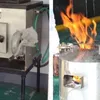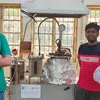Here are 5 STEM innovations by young girls across India
Quest Alliance and IBM conducted a Hackathon to inculcate the STEM mindset among children, with the participation of over 90 students across four states in two months.
According to a study published by Quest Alliance, a not-for-profit trust that equips young people with 21st-century skills by enabling self-learning, women only constitute about 14 per cent of the 280,000 scientists and engineers in research and development institutes in India. This number is an indication of the low participation of women in STEM (science, technology, engineering, and mathematics) disciplines.
So, in partnership with IBM, Quest Alliance is trying to tackle this gender disparity by designing and organising programmes such as STEM for Girls Hackathon, which saw participation from 90 students across Karnataka, Telangana, and Odisha in a two-month-long process.
The Hackathon, which was a celebration of ideas, design thinking, innovation, and collaboration was goaled to embed the STEM mindset among the children.
The event engaged the students in ideating, innovating, experimenting, creating, and tinkering with ideas, giving a stepping stone for next-gen leaders to take charge of their future.
SocialStory lists a few innovations by these students that can go a long way in making our planet sustainable and the social space thriving.
Sanitary disposal machine

A prototype of the sanitary disposal machine by one of the students
Sanitary napkin disposal is a challenge in itself as incinerators release a lot of toxic smoke. So, the students took to addressing the proper disposal of sanitary napkins. They designed and built an eco-friendly machine as a prototype to burn napkins, thereby reducing toxicity and releasing less smoke without a foul smell.
To make it cost-effective and also to save electricity, the machine can burn about six napkins at a time, and the ash released needs to be reheated to remove the toxins that are harmful to us and our environment.
Vacuum garbage collection

A prototype of the garbage vacuum cleaner
Garbage on the roads is becoming a growing urban menace. The students were challenged to come up with a solution to tackle garbage on the streets. They came up with a garbage collection device called the ‘Garbage Collector’ that not only picks up garbage through a vacuum but also separates it into dry and wet waste.
Destoner for rice

Destoner prototypes by the students
Students observed that while mothers have to pick stones while cleaning rice, which is a time-consuming process. After doing some user and background research, the team came up with an idea for a ‘destone’ prototype that separates the stones from the rice.
The battery-operated machines consist of a vibrating sieve which filters out stones from the rice.
Self-operated dishwasher

Battery-operated dishwasher
The students were posed with a challenge to reduce the efforts of people who were cleaning the utensils at home. While washing the dishes can be time-consuming, it is also quite strenuous.
After taking feedback from their parents, the students made a battery-operated spinning scrubber that removes stains from the dishes by just holding the utensil against the scrubber. The scrubber is cost-efficient and can be operated with the help of solar power to save electricity, and adjusting the speed accordingly.
Hawa Hawaii
The students working on this project had to come up with a multipurpose cleaning tool for wet cleaning. During the lockdown, the students realised that it was difficult for them and their mothers to do household cleaning, especially cleaning wet floors.
Their solution? ‘Hawa Hawaii’, a battery-operated machine that cleans the floor and reduces the back pain for users while doing these household chores. This machine has a handle that is connected to a scrubber to clean the floor and can regulate the amount of water that is needed on the floor while cleaning. This allows them to use just the right amount of water enough to clean that surface.
Edited by Kanishk Singh










